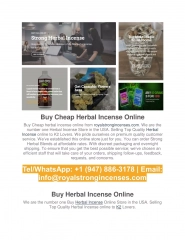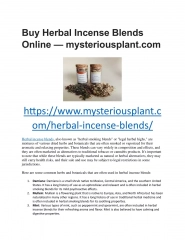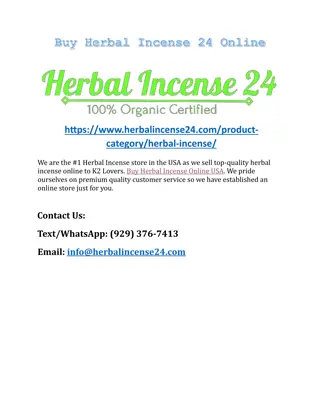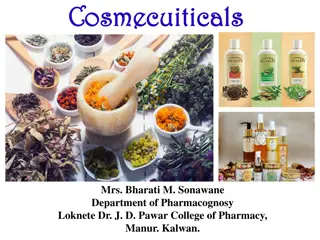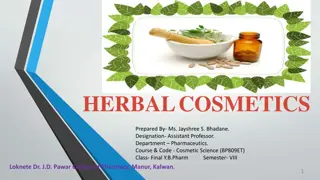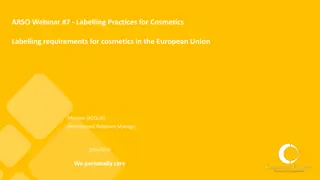Exploring Herbal Cosmetics: Ancient Origins to Modern Applications
Herbal cosmetics have a rich history dating back to ancient times, where natural ingredients were used for both decoration and protection. Today, herbal cosmetics are formulated with various ingredients to offer specific benefits to the skin and hair. Fixed oils, such as coconut oil and olive oil, are essential components in herbal cosmetics, providing moisturizing, hydrating, and protective properties. Discover the wonders of herbal cosmetics and their role in enhancing beauty naturally.
Download Presentation

Please find below an Image/Link to download the presentation.
The content on the website is provided AS IS for your information and personal use only. It may not be sold, licensed, or shared on other websites without obtaining consent from the author. Download presentation by click this link. If you encounter any issues during the download, it is possible that the publisher has removed the file from their server.
E N D
Presentation Transcript
Herbal Cosmetics Part-1
. The word cosmetic was derived from the Greek word kosm tikos meaning having the power, arrange, skill in decorating. The origin of cosmetics forms a continuous narrative throughout the history of man as they developed. The man in ancient times 3000BC used colors for decoration to attract the animals that he wished to hunt and also the man survived attack from the enemy by coloring his skin and adorned his body for protection to provoke fear in an enemy (whether man or animal).
. Herbal cosmetics, here refered as products, are formulated using various ingredients to form the base in which one or more herbal ingredients are used to provide difined cosmetic advantages only, shall be called as Herbal Cosmetics. Herbs can be utilized for cosmetics in three forms: as total extracts, selective extracts or single molecules purified from extracts. The beauty of skin and hair basically depends on factors such as individual s health, diet, habits, job routine, climatic conditions and maintenance. permissible cosmetic
Fixed oil Fixed oil are obtained from plants and animal. They are mostly present in seed. Physical property Can not be distilled Leaves a permanent, translucent stain on filter paper Specific gravity gravity is less than 1 Insoluble in water Application of fixed oil Soap manufacture Emulsifying agent Dietery supplements Manufacture of paints, varnishes
Source of fixed Oil 1. Coconut oil : Coconut oil is obtained from the fruit or seed of the coconut palm tree Cocos nucifera, family Arecaceae. Coconut oil is an excellent skin moisturizer and softener. A study shows that extra virgin coconut oil is effective and safe when used as a moisturizer, with absence of adverse reactions. A study found that coconut oil helped prevent protein loss from the wet combing of hair when used for fourteen hours. The lauric acid that coconut oil is rich in has significant action against viruses, bacteria and fungi and this ensures you keep away from infections of the scalp.
2. Olive oil: It is obtained from pericarp of the fruits of Olea europaea from family oleaceae. The ripe fruit are crushed and packed in bags and screw press pass mounts pressure. The first quality oil is called Virgin oil. Olive oil contain mixed glycerides of oleic acid (56-85%), palmitic acid (7-20%) linoleic (3-20%). Olive oil is used as demulcent, emollient, laxative properties. Olive oil have antioxidant property and have an ingredient called squalene which is very hydrating, it moisturizes the delicate skin in the eye area and nourishes the eyelashes. Olive oil is great for hair because of the several properties it has an excellent hair conditioner property.
3.Almond oil: The almond oil is a fixed oil obtained by expression from the seeds of Prunus amygdalus var. dulcis (sweet almond) & var. amara (bitter almond) (Rosaceae) . The almond oil basically contains about 40-55% of fixed oil, about 20% protein. This oil contains very small amounts of super-unsaturated Omega-3 essential fatty acids. Almond oil is an emollient, and use in preparation of toilet product. It proves to be very nourishing, and softens and strengthens the hair. The almond oil also proves to be a very good cleansing agent. Almond oil has been used for many centuries, even before its spread as a commercial agro-product.
4. Castor oil: Castor oil is the fixed oil obtained by cold expression of the seeds of Ricinus communis, fam., Euphorbiaceae. Castor oil consist of glycerides of recinoleic acid, stearic and dihyroxy stearic acid. Ricinoloeic acid is responsible for laxative property. Castor oil contain vit. F. Ricinoleic acid is an 18 carbon acid having the doulble bond in the 9-10 position. Castor oil is used as mild purgative, ointment base, as plasticizer, wetting agent, lubricating agent. Also use as emollient in the preparation of lipistics, in tooth formulation, as ingredient in hair oil. Vit. F is composed of two fatty acids- linoleic acid (LA) and alpha-linoleic acid (LNA). In skin care, linoleic acid provides anti-inflammatory, moisturizing and healing effect. It also softens the skin and facilitate the penetration of other active ingredients.
5. Sesame oil: Sesame oil is obtained from Sesamum indicum Linn. Family pedaliaceae. There are many varieties of sesame oil that range in flavor and color. Sesame oil is highly lubricating. Other than being used as flavour enhancing cooking oil, it has great beauty benefits and works great for scalp and hair growth. Sesame oil is enriched with Vitamin E, B complex and minerals such as phosphorus and protein which strengthens the hair from the root and gives deep nourishment. nourishing, healing and magnesium, calcium,
6. Mustard oil: Mustard oil is extracted from the seeds of the mustard plant, which refers to any of the family in the genera Sinapis and Brassica. Examples are Brassica nigra or Black Mustard. Mustard seeds are rich in antioxidants, protein and fatty acids, many experts advise using natural or herbal remedies for such common problem as hair thinning and loss.
7. Grapeseed oil: Grapeseed oil which can be commonly seen in grocery stores comes from pressed grape seeds. It is lightweight, colorless, and odorless, making it very versatile. Because of its moisturizing properties, it has become one of the most popular ingredients for cosmetic products, aromatherapy, and even shampoos and conditioners. and regenerative



